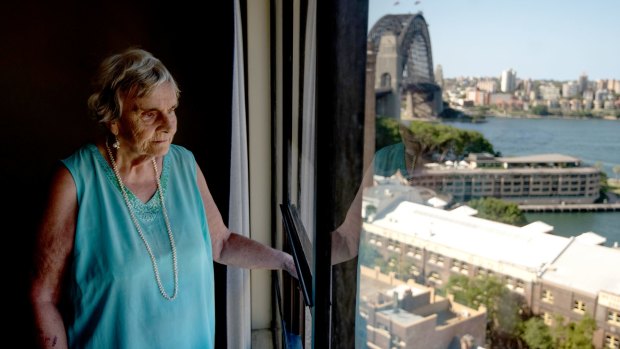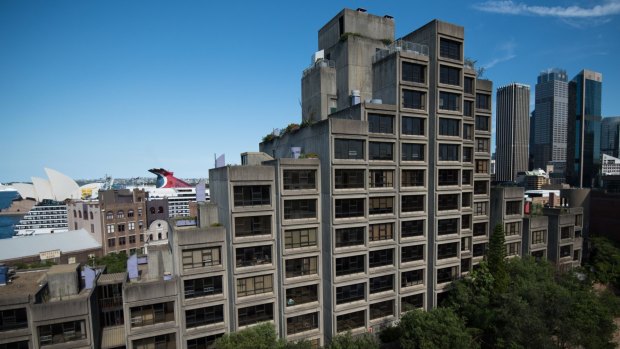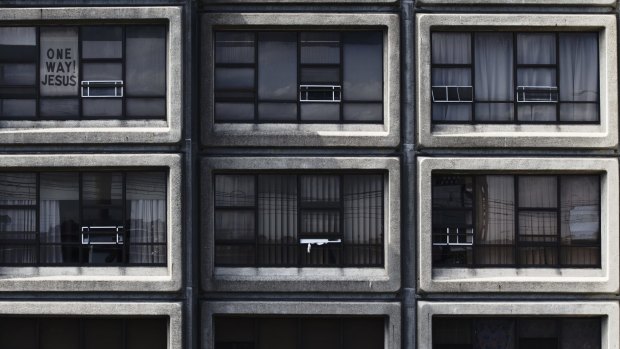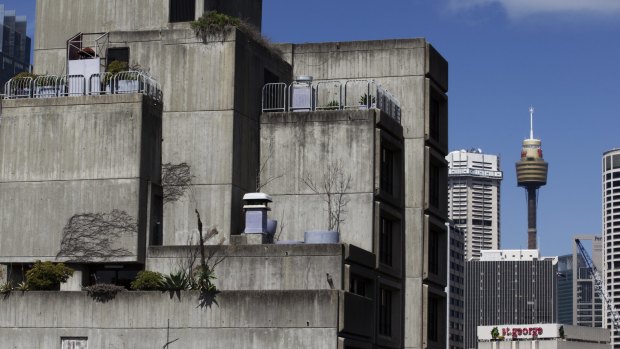By Lisa Visentin
At 9am on Sunday, the remaining 12 residents of the Sirius building in The Rocks woke to a sharp knock at their doors.
A employee from the Department of Family and Community Services had arrived with a message: they were out.
The government had decided that their home, the brutalist behemoth in The Rocks that had housed up to 200 low-income tenants in its stacked concrete boxes for almost four decades, was not deserving of heritage-status.
"She said we had lost. That's it, we would be relocated," says Ruby Martin, 52, who has lived in the building for 11 years.

Myra Demetriou, 89, has been a tenant in the Sirius building since 2008.Credit: Wolter Peeters
In the two-and-a-half years since the government announced its decision to sell public housing in The Rocks and Millers Point to fund more social housing elsewhere, the Sirius building had come to act as a lightning rod for opponents and champions of the policy.
For critics of the sell-off, the building was a physical expression of a certain type of progressive planning. Yes – working class people could also have harbour views, this building said. Furthermore, governments might help them do so. And in its brusque, brutalist architecture, the building made no apologies for itself or what it represented.
But for the proponents, the Sirius simply made no sense – aesthetically or economically. Its square concrete frames jarred with the sandstone charm of The Rocks. And if the government sold the site, it could use the millions raised to help many more low-income residents right across the city and state.
Social Housing Minister Brad Hazzard, responsible for a public housing waiting list of about 60,000, is firmly in the latter camp.

Located on Cumberland Street in The Rocks, the Sirius building's brutalist concrete box architecture has divided public opinion for almost 40 years. Credit: Wolter Peeters
"My only interest is to try and get the maximum dollars to build more social housing," Hazzard says.
Hazzard is familiar with the numbers. Since the government announced its Rocks and Millers Point sales on March 19, 2014, it has raised over $260 million. The funds have been used to pay for 600 new social housing dwellings, mostly in Western Sydney. For instance – 134 homes in Bankstown, 80 in Fairfield and 50 in Penrith.

The Sirius building has 79 apartments, which can house up to 200 people. Only 12 residents, living in eight apartments, remain. Credit: Louis Douvis
The Sirius sale is expected to net at least another $100 million. Had the building been heritage listed, this figure may have been reduced by as much as $70 million, the government says.
In one sense, however, this controversy reflects a debate that has been raging from the time of the Sirius' construction in the 1970s, and its opening in March 1980.

Environment Minister Mark Speakman rejected a bid to have the Sirius building preserved on the state heritage register. Credit: Louis Douvis
The National Trust, which now laments the impending destruction of the Sirius as another attack on the city's physical history, then derided the building as "the lump on the Rocks". Its architect, Tao Gofers, never accepted the criticism, declaring at the time that people would come to accept the building "in three or four years".
At best, however, the building has gathered a cult-like affection for its unique hideous beauty, and its status as a quasi-monument to the Australian egalitarian spirit.
It was these elements that underscored the Heritage Council's bid, late last year, to preserve the Sirius. In its unanimous recommendation that the building be heritage listed, the council focused on two grounds: its integrity as an example of brutalist architecture; and its history as a response to the Green Bans movement of the 1960s and 1970s.
It is notable that in rejecting their submission this week, Environment Minister Mark Speakman did not reject outright their arguments. Rather, in sealing Sirius' date with a wrecking ball, he said that "even if it reached a threshold for State heritage significance" the cost of that listing would be unjustifiable.
Speakman insisted this decision did not indicate an ethos of "money trumps heritage". And Hazzard, meanwhile, says the government is not assessing for sale any of its other housing assets in inner Sydney. "There is no proposal whatsoever to go repeating Millers Point," he says.
Nor, he says in response to the inevitable question, does the sell off of Millers Point to fund social housing in Sydney's west amount to social cleansing.
All of the Millers Point residents, Hazzard says, have been given priority access to accommodation "in the immediate area", with many of them relocated close to central Sydney.
However, to many, Speakman's prerogative speaks to a broader concern about the Baird government's unapologetically commercial outlook.
"They don't think people like me should have these views," is how Sirius' oldest resident, Myra Demetriou, 89 puts it.
The National Trust president, Clive Lucas, says: "This is the most recent in a series of decisions damaging Sydneysiders' 'sense of place' in pursuit of money."
And renowned unionist Jack Mundey, who led the historic Green Ban movement as head of the Builders' Labourers Federation, says the government is effectively scrubbing the inner city of its social history.
"The whole history of The Rocks is the working class," says Mundey, now in his 80s. "That is being eroded."
Mundey's movement, which is widely credited with saving The Rocks from high rise development and protecting the low-income neighbourhood from eviction, formed a key part of the National Trust's submission to have the apartment block heritage listed.
But that historical interpretation is also contested, according to one of the consultants who briefed the Heritage Council on the merits of the building's Heritage application.
"This building has been very divisive within the profession about whether or not it is significant and why it is significant," Maclaren North, the NSW director of consultancy firm Extent Heritage, says.
Dr North, who was hired by FACS to evaluate the building's historical connection to the Green Ban movement, concluded that over the years "a mythology had built up around the building".
He says his position is grounded in primary documents from the time, which he said could support "a general era connection" between the Sirius building and the Green Ban movement but a direct connection was "a lot more tangential".
"I am a firm believer in the heritage listing process, but I believe if it's going to be credible, it's got to be robust," says North. "A lot of the claims simply did not stack up."
But for the remaining 12 residents, the heritage listing debate was largely academic.
"I feel like I belong here," Ruby Martin said on Wednesday. "These people are my family."
Residents have been given the option of relocating to one of the remaining public housing units in Millers Point, that were quarantined from the sell-off and have since been refurbished.
But with some of her neighbours digging in, an unedifying showdown is brewing for the government. And Hazzard did not rule out the possibility the building would be sold out from under them.
"A lot depends on whether they are going to work with us or against us," he added.